A kenning is a figure of speech in the type of circumlocution, a compound that employs figurative language in place of a more concrete single-word noun. Kennings are strongly associated with Old Norse-Icelandic and Old English poetry. They continued to be a feature of Icelandic poetry for centuries, together with the closely related heiti.

Lake Ladoga is a freshwater lake located in the Republic of Karelia and Leningrad Oblast in northwestern Russia, in the vicinity of Saint Petersburg.
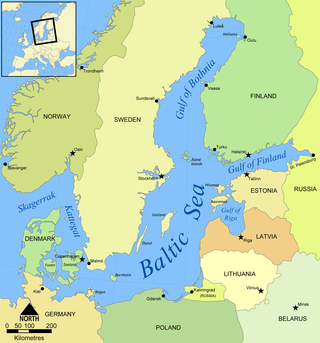
The Gulf of Bothnia is divided into the Bothnian Bay and Bothnian Sea, and it is the northernmost arm of the Baltic Sea, between Finland's west coast and the Sweden's east coast. In the south of the gulf lies Åland, between the Sea of Åland and the Archipelago Sea.

Drøbak is a town and the centre of the municipality of Frogn, in Viken county, Norway. The city is located along the Oslofjord, and has 13,409 inhabitants.
Bygdøy or Bygdø is a peninsula situated on the western side of Oslo, Norway. Administratively, Bygdøy belongs to the borough of Frogner; historically Bygdøy was part of Aker Municipality and became part of Oslo in 1948.

Grefsen is a neighbourhood in the city of Oslo, Norway.

A Viking ring fortress, or Trelleborg-type fortress, is a type of circular fort of a special design, built in Scandinavia during the Viking Age. Collectively, they may also be known as trelleborgs. These fortresses have a strictly circular shape, with roads and gates pointing in the four cardinal directions. They are sometimes partially encircled by advanced ramparts, though not always circular.
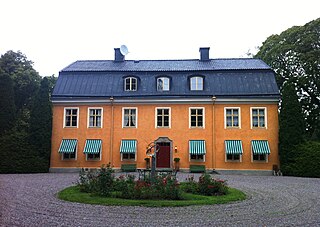
Signhildsberg is a manor that formerly was a royal estate, located in the parish of Håtuna approximately 4 kilometres (2.5 mi) west of the modern town of Sigtuna, by Lake Mälaren in Sweden. Although the location is nearly forgotten, it has a central role in Norse mythology, according to which it was founded by the Norse god Odin.

Blindern is the main campus of the University of Oslo, located in Nordre Aker in Oslo, Norway.

Stavern is a small water-side town in Larvik municipality in Vestfold County, Norway. It is south of the city of Larvik. Currently there are around 3,000 inhabitants in Stavern. It is a small town where tourism is one of the most important sources of income. During summer, the population increases to around 30,000-40,000 people, due to camping sites and cottages around the town centre as well as boats visiting the harbour.

Akerselva or Akerselven is a river which flows through Oslo. It starts at Maridalsvannet in Oslomarka, and traverses the boroughs of Nordre Aker, Sagene, Grünerløkka, central Oslo and Grønland, whereby it finally ends at Paulsenkaien and Oset in Bjørvika. The river is considered to be a part of the Nordmarkvassdraget, and has the Norwegian watercourse number 006.Z. The entire river is about 8.2 kilometres (5.1 mi) long, and has a difference in elevation between source and mouth of approximately 149 metres (489 ft).
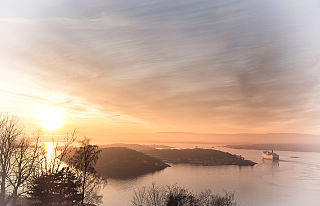
Hovedøya is one of several small islands off the coast of Oslo, Norway in the Oslofjord. The island is quite small, no more than 800 metres across in any direction, the total area is 0,4 square kilometre. It is well known for its lush and green nature, with a wide variety of trees, bushes and flowers. For many, many years there was a military base on the island.
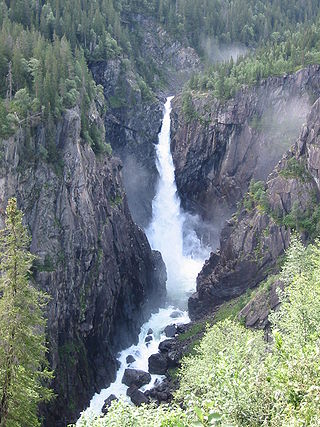
Rjukan Falls is a waterfall of 104 metres in the western part of the Westfjord valley in Tinn, a municipality in the county of Vestfold og Telemark, Norway, west of the industrial town Rjukan. The waterfall is a part of the Måne river, earlier a major tourist attraction, being one of the first floodlighted waterfalls by electricity produced by the same waterfall. In 1905 Rjukan Falls was built out to produce hydro electrical power for the saltpetre production when Norsk Hydro was established.

Glemmen is a parish and former municipality with the city of Fredrikstad, Østfold county, Norway.
Aker was a former independent municipality in Akershus, Norway, that constitutes the vast majority of the territory of the modern city of Oslo.

Bjørvika is a neighborhood in the Sentrum borough of Oslo, Norway. The area is an inlet in the inner Oslofjord, situated between Gamlebyen and Akershus Fortress. It serves as an outlet for the river Akerselva. Since the 2000s, it has been undergoing urban redevelopment, being transformed from a container port. When completed, the Bjørvika neighborhood will be a new cultural and urban center in Oslo. The multi-purpose medium-rises of the Barcode Project dominates the skyline to the north; to the east the residential area of Sørenga is under construction. The National Opera is located at Bjørvika, and both the Oslo Public Library and the Munch/Stenersen museum is currently under construction here, the latter replacing the existing Munch Museum in 2020.

Gothic is an extinct East Germanic language that was spoken by the Goths. It is known primarily from the Codex Argenteus, a 6th-century copy of a 4th-century Bible translation, and is the only East Germanic language with a sizeable text corpus. All others, including Burgundian and Vandalic, are known, if at all, only from proper names that survived in historical accounts, and from loanwords in other languages such as Portuguese, Spanish, Catalan, Occitan and French.
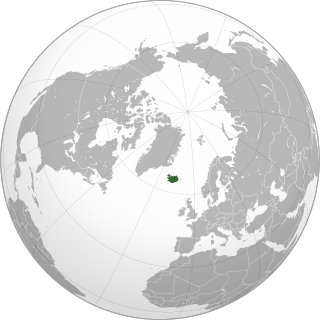
Icelandic is a North Germanic language spoken by about 314,000 people, the vast majority of whom live in Iceland, where it is the national language. Due to being a West Scandinavian language, it is most closely related to Faroese, western Norwegian dialects, and the extinct language Norn.

Rådhusplassen is a square located between Oslo City Hall and the Oslofjord in Vika, Oslo, Norway. Previously used as a road and part of European route E18, it has since 1994 served as a recreational area. North of the square stands the city hall, to the south the fjord, to the east Akershus Fortress and to the east the former Western Railway Station.
Old Norse has three categories of verbs and two categories of nouns. Conjugation and declension are carried out by a mix of inflection and two nonconcatenative morphological processes: umlaut, a backness-based alteration to the root vowel; and ablaut, a replacement of the root vowel, in verbs.

















